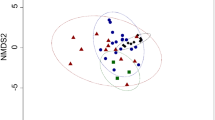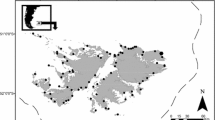Abstract
Understanding the dietary habits of yellow-billed loons (Gavia adamsii) can give important insights into their ecology, however, studying the diet of loons is difficult when direct observation or specimen collection is impractical. We investigate the diet of yellow-billed loons nesting on the Arctic Coastal Plain of Alaska using quantitative fatty acid signature analysis. Tissue analysis from 26 yellow-billed loons and eleven prey groups (nine fish species and two invertebrate groups) from Arctic lakes suggests that yellow-billed loons are eating high proportions of Alaska blackfish (Dallia pectoralis), broad whitefish (Coregonus nasus) and three-spined stickleback (Gasterosteus aculeatus) during late spring and early summer. The prominence of blackfish in diets highlights the widespread availability of blackfish during the early stages of loon nesting, soon after spring thaw. The high proportions of broad whitefish and three-spined stickleback may reflect a residual signal from the coastal staging period prior to establishing nesting territories on lakes, when loons are more likely to encounter these species. Our analyses were sensitive to the choice of calibration coefficient based on data from three different species, indicating the need for development of loon-specific coefficients for future study and confirmation of our results. Regardless, fish that are coastally distributed and that successfully overwinter in lakes are likely key food items for yellow-billed loons early in the nesting season.


Similar content being viewed by others
References
Bailey AM (1922) Notes on the yellow-billed loon. Condor 24:204–205
Ball J, Esler D, Schmutz J (2007) Proximate composition, energetic value, and relative abundance of prey fish from the inshore eastern Bering Sea: implications for piscivorous predators. Polar Biol 30:699–708
Barr JF (1996) Aspects of common loon (Gavia immer) feeding biology on its breeding ground. Hydrobiologia 321:119–144
Barr JF, Eberl C, Mcintyre JW (2000) Red-throated Loon (Gavia stellata). The Birds of North America Online (A. Poole, Ed.). Ithaca: Cornell Lab of Ornithology. Retrieved from the Birds of North America Online: http://bna.birds.cornell.edu/bna/species/513
Barrett RT, Camphuysen K, Anker-Nilssen T, Chardine JW, Furness RW, Garthe S, Huppop O, Leopold MF, Montevecchi WA, Veit RR (2007) Diet studies of seabirds: a review and recommendations. ICES J Mar Sci 64:1675–1691
Beck CA, Iverson SJ, Bowen WD, Blanchard W (2007) Sex differences in grey seal diet reflect seasonal variation in foraging behaviour and reproductive expenditure: evidence from quantitative fatty acid signature analysis. J Anim Ecol 76:490–502
Bolnick DI, Svanbäck R, Fordyce JA, Yang LH, Davis JM, Hulsey CD, Forister ML (2003) The ecology of individuals: incidence and implications of individual specialization. Am Nat 161:1–28
Bromaghin JF, Lance MM, Elliott EW, Jeffries SJ, Acevedo-Gutiérrez A, Kennish JM (2013) New insights into the diets of harbor seals (Phoca vitulina) in the Salish Sea revealed by analysis of fatty acid signatures. Fish Bull 111:13–26
Budge SM, Iverson SJ (2003) Quantitative analysis of fatty acid precursors in marine samples direct conversion of wax ester alcohols and dimethylacetals to FAMEs. J Lipid Res 44:1802–1807
Budge SM, Iverson SJ, Bowen WD, Ackman RG (2002) Among- and within-species variability in fatty acid signatures of marine fish and invertebrates on the Scotian Shelf, Georges Bank, and southern Gulf of St. Lawrence. Can J Fish Aquat Sci 59:886–898
Budge SM, Iverson SJ, Koopman HN (2006) Studying trophic ecology in marine ecosystems using fatty acids: a primer on analysis and interpretation. Mar Mamm Sci 22:759–801
Budge SM, Penney SN, Lall SP (2012) Estimating diets of Atlantic salmon (Salmo salar) using fatty acid signature analyses; validation with controlled feeding studies. Can J Fish Aquat Sci 69:1033–1046
Collett P (1894) On the occurrence of Colymbus adamsi in Norway. Ibis 36:269–283
Cottam C, Knappen P (1939) Food of some uncommon North American birds. Auk 56:138–169
Craig PC (1984) Fish use of coastal waters of the Alaskan Beaufort Sea: a review. Trans Am Fish Soc 113:265–282
Dunshea G (2009) DNA-based diet analysis for any predator. PLoS ONE 4:e5252
Haynes TB, Rosenberger AE, Lindberg MS, Whitman M, Schmutz JA (2013) Method- and species-specific detection probabilities of fish occupancy in Arctic lakes: implications for design and management. Can J Fish Aquat Sci 70:1055–1062
Haynes TB, Rosenberger AE, Lindberg MS, Whitman M, Schmutz JA (2014a) Patterns of lake occupancy by fish indicate different adaptations to life in a harsh Arctic environment. Freshw Biol 59:1884–1896
Haynes TB, Schmutz JA, Lindberg MS, Rosenberger AE (2014b) Risk of predation and weather events affect nest site selection by sympatric Pacific (Gavia pacifica) and yellow-billed (Gavia adamsii) loons in Arctic habitats. Waterbirds 37:16–25
Haynes TB, Schmutz JA, Lindberg MS, Wright KG, Uher-Koch BD, Rosenberger AE (2014c) Occupancy of yellow-billed and Pacific loons: evidence for interspecific competition and habitat mediated co-occurrence. J Avian Biol 45:296–304
Iverson SJ, Frost KJ, Lang S (2002) Fat content and fatty acid composition of forage fish and invertebrates in Prince William Sound, Alaska: factors contributing to among and within species variability. Mar Ecol Prog Ser 241:161–181
Iverson SJ, Field C, Bowen WD, Blanchard W (2004) Quantitative fatty acid signature analysis: a new method of estimating predator diets. Ecol Monogr 74:211–235
Iverson SJ, Springer AM, Kitaysky AS (2007) Seabirds as indicators of food web structure and ecosystem variability: qualitative and quantitative diet analyses using fatty acids. Mar Ecol Prog Ser 352:235
Jehl JR Jr (1970) A Mexican specimen of the yellow-billed loon. Condor 72:376
Kenow KP, Wilson JM, Meyer MW (2009) Capturing common loons during prenesting and nesting periods. J Field Ornithol 80:427–432
Korschgen CE, Kenow KP, Gendron-Fitzpatrick A, Green WL, Dein FJ (1996) Implanting intra-abdominal radiotransmitters with external whip antennas in ducks. J Wildl Manag 60:132–137
Meynier L, Morel PCH, Chilvers BL, Mackenzie DDS, Duignan PJ (2010) Quantitative fatty acid signature analysis on New Zealand sea lions: model sensitivity and diet estimates. J Mamm 91:1484–1495
North MR (1994) Yellow-billed loon (Gavia adamsii). The Birds of North America Online (A. Poole, Ed.). Ithaca: Cornell Lab of Ornithology; Retrieved from the Birds of North America Online: http://bna.birds.cornell.edu/bna/species/121
North MR (2008) Activity budgets and habitat use by yellow-billed loons in Alaska. Big Deep Lake Publishing, Pillager
Owen E, Daunt F, Wanless S (2010) Sampling avian adipose tissue: assessing a nondestructive biopsy technique. J Field Ornithol 81:92–98
Reist JD, Bond WA (1988) Life history characteristics of migratory coregonids of the lower Mackenzie River, Northwest Territories, Canada. Finn Fish Res 9:133–144
Rizzolo DJ, Schmutz JA (2009) Monitoring marine birds of concern in the Eastern Chukchi Nearshore Area (Loons). Annual Report for 2009 to Minerals Management Service, Alaska Region, p 55
Russell RW (2002) Pacific Loon: Gavia pacifica: Arctic Loon: Gavia arctica. The Birds of North America Online (A. Poole, Ed.). Ithaca: Cornell Lab of Ornithology; Retrieved from the Birds of North America Online: http://bna.birds.cornell.edu/bna/species/657a
Salyer JW (1962) A bow-net trap for ducks. J Wildl Manag:219–221
Schmutz JA, Wright KG, DeSorbo CR, Fair J, Evers DC, Uher-Koch BD, Mulcahy DM (2014) Size and retention of breeding territories of yellow-billed loons (Gavia adamsii) in Alaska and Canada. Waterbirds 37:53–63
Scholander PF, Flagg W, Hock RJ, Irving L (1953) Studies on the frozen plants and animals in the Arctic. J Cell Comp Physiol 42:1–56
Sih A, Christensen B (2001) Optimal diet theory: when does it work, and when and why does it fail? Anim Behav 61:379–390
Uher-Koch BD, Schmutz JA, Wright KG (2015) Nest visits and capture events affect breeding success of Yellow-billed and Pacific loons. Condor 11:121–129
Uspenskii SS (1969) Life in high latitudes, a study of bird life. Transl. from Russ. by Amerind Publ. Co. Pvt. Ltd., New Delhi, for U.S. Dept. Int. and Natl. Sci. Found. Washington, D.C
Wang S, Hollmén T, Iverson S (2010) Validating quantitative fatty acid signature analysis to estimate diets of spectacled and Steller’s eiders (Somateria fischeri and Polysticta stelleri). J Comp Physiol B 180:125–139
White TCR (1978) The importance of a relative shortage of food in animal ecology. Oecologia 33:71–86
Wiens JA, Rotenberry JT (1979) Diet niche relationships among North American grassland and shrubsteppe birds. Oecologia 42:253–292
Woo KJ, Elliott KH, Davidson M, Gaston AJ, Davoren GK (2008) Individual specialization in diet by a generalist marine predator reflects specialization in foraging behaviour. J Anim Ecol 77:1082–1091
Acknowledgments
Laboratory preparation and analysis were possible thanks to the assistance of J. Morehouse, B. Baker, S. Merrill, the Causey lab, S. Al-Shaghay and the Iverson lab. Field data were collected by T. Buckley, E. Dykstra, S. Furusawa, I. Isler, L. Koloski, C. Margolin, J. McCarter, K. Overdjuin, B. Price, T. Shoemaker, S. Stortz, A. Tate, B. Uher-Koch and K. Wright. This project was funded by a State Wildlife Grant awarded through Alaska Department of Fish & Game and the U.S. Geological Survey’s Changing Arctic Ecosystem Initiative, supported, in part, by the Wildlife Program of the USGS Ecosystem Mission Area. S. Wang made helpful suggestions during our analysis stage. J. Pearce, M. Lindberg, K. Titus, and two anonymous reviewers provided useful reviews that improved the manuscript. TBH was funded by a postgraduate scholarship provided by the Natural Sciences and Engineering Research Council of Canada (NSERC) and a Changing Alaska Science Education graduate fellowship provided by the National Science Foundation. Additional support was provided by NSERC research and equipment grants to SJI. Any use of trade, firm or product names is for descriptive purposes only and does not imply endorsement by the U.S. Government.
Author information
Authors and Affiliations
Corresponding author
Electronic supplementary material
Below is the link to the electronic supplementary material.
Rights and permissions
About this article
Cite this article
Haynes, T.B., Schmutz, J.A., Bromaghin, J.F. et al. Diet of yellow-billed loons (Gavia adamsii) in Arctic lakes during the nesting season inferred from fatty acid analysis. Polar Biol 38, 1239–1247 (2015). https://doi.org/10.1007/s00300-015-1690-3
Received:
Revised:
Accepted:
Published:
Issue Date:
DOI: https://doi.org/10.1007/s00300-015-1690-3




